Family : Rhincodontidae

Text © Giuseppe Mazza

English translation by Mario Beltramini
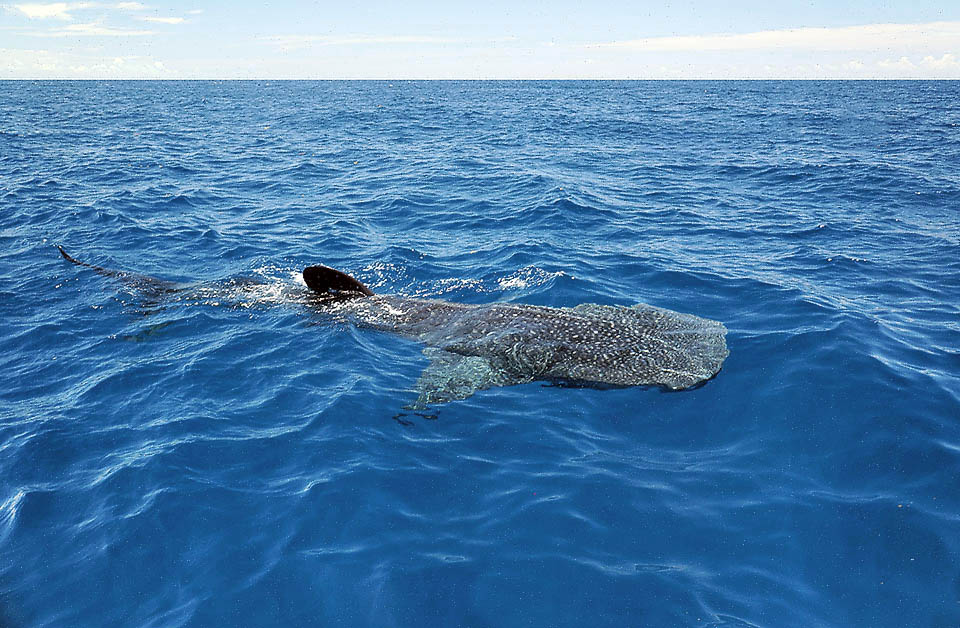
Except for Mediterranean, the Whale Shark (Rhincodon typus) is present in tropical and warm temperate seas throughout the world © Julian Pietragalla
The Whale shark (Rhincodon typus Smith, 1828) belongs to the class of the Chondrichthyes, the cartilaginous fishes, to the order of the Orectolobiformes, that of the “carpet sharks” such as the Eucrossorhinus dasypogon or the Stegostoma fasciatum, called so because their livery at times imaginative and refined, and to the family of the Rhincodontidae counting only this species.
The name of the genus Rhincodon comes from the Greek “ρύγχος” (rhynchos) = snout and “ὀδούς” (odous) = tooth, because of the 300 tiny rows of teeth that this giant fish displays like a grater on its jaws.
The specific name typus reminds us, from the Latinized Greek, that it has a typical and unique shape, so much that the taxonomists had to create a new family tailored just all for it.
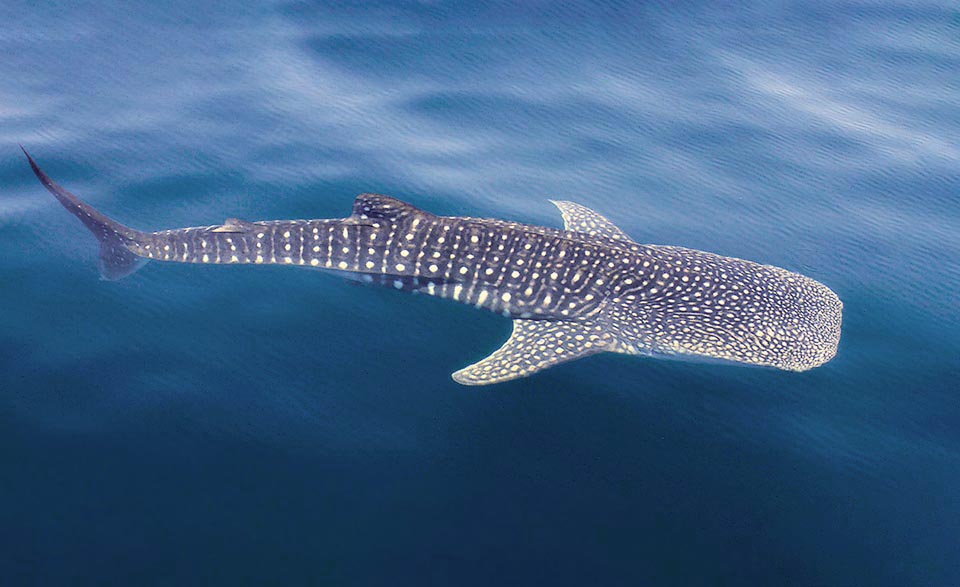
It is a pelagic species in continuous movement in search of food with more frequented gathering points for eating or mating reasons © Ernesto Solana
Zoogeography
Apart the Mediterranean, the Whale shark is present in the tropical and warm temperate seas of all the world with some more visited “gathering points”, during the migrations, for food and coupling reasons.
Indicatively, it is often sighted in the Red Sea and we find it in the Indo-Pacific from the Africal coasts and Madagascar to India and then in Malaysia, Australia, Indonesia, Papua New Guinea, Polynesia and farther. Northwards it is present in the waters of the Philippines, where, in Oslob, seen that it is a pacific animal, completely harmless for the man, it has been even created an ecotourism with young specimens attracted by means of shrimps every morning for the enjoyment of the divers, and reaches then Taiwan, where until 2008 these animals were sold at the fish market.
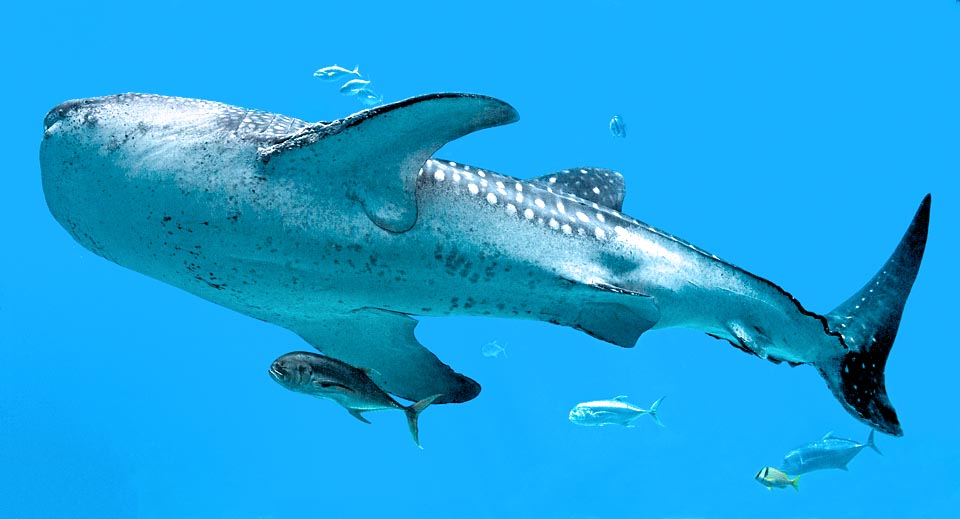
With 17-20 m in length and a maximum weight of 34 tons, it is the biggest extant fish. Even the skin breaks all records with 15 cm of thickness © Giuseppe Mazza
And it is rightly from this very far site that have left, at the fish price, before that the international conventions forbade it, the 6 specimens intended for the Atlanta Aquarium, in Georgia, that presently hosts 2 couples.
The whale shark is frequent also in the waters close to California and on both Mexican coasts, in particular between the Gulf of Mexico and the Caribbean Sea, where in 2011, off Yucatan, have been counted more than 400 specimens with an unbelievable and unbearable influx of tourists.
Ecology-Habitat
The Rhincodon typus is a pelagic species in continuous movement looking for food.
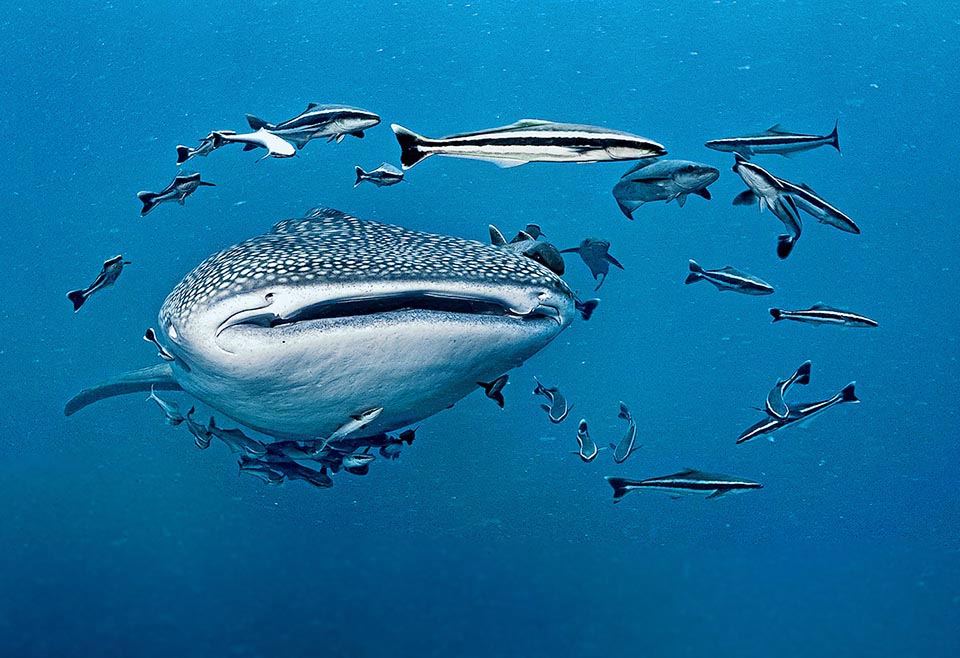
The head, wide and flat with tiny eyes, ends with a huge mouth, even up to a meter and a half wide, placed in front and not underneath, like usually among the sharks © Bert Klangpremchitt
Usually it swims in waters at 18-30 °C, between the surface and 100 m of depth, but get down up to around the 2000 m, with ample circles crossing in an eight, to chase herds of substantial food sources.
It often approaches the coasts in the passing places rich of krill or where the inhabitants of the reef reproduce simultaneously in mass. Therefore we find it often at the entrance of lagoons and atolls or at the mouth of the rivers.
Morphophysiology
The Whale shark is the biggest extant fish. Stranded, with the huge caudal fin, it may reach the 20 m of length, but actually, when at sea, with the fin erect, it seems that rarely it exceeds the 17 m. It weighs about 10 t, with a record of 34 t, even if there is some talking of 40 t. The skin, rough and hard when touched, can reach the 15 cm of thickness.
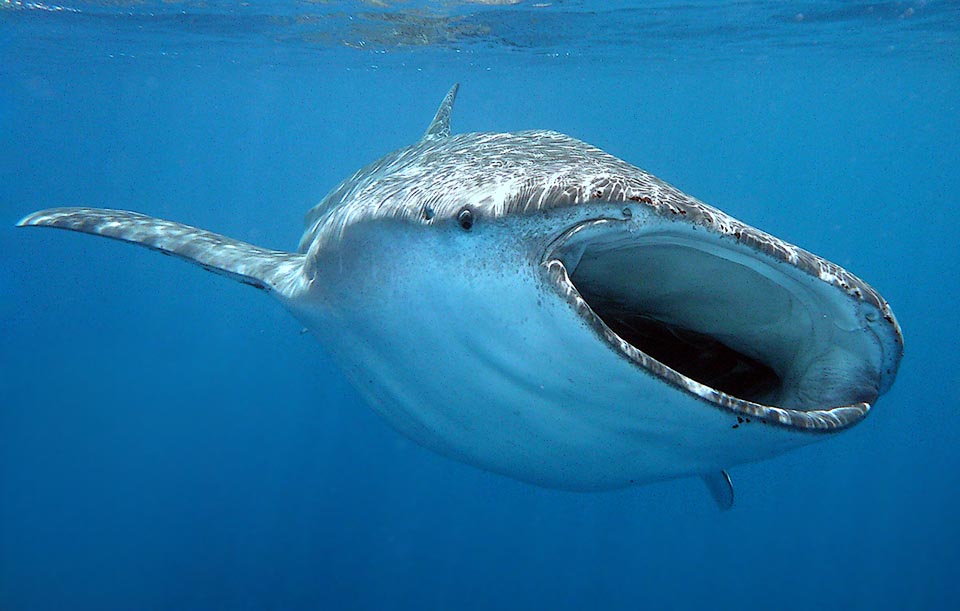
Here it is wide open. It has 300 rows of tiny teeth, useless vestiges of a distant past, its feeding is entrusted to a filtering structure of teeth on gill blades © sea-kangaroo
Proportions made the fins follow more or less the usual scheme of the fishes with the two dorsal in a relatively backward position and huge pectoral ones shaped like a sickle.
The heterocercal caudal fin has the upper lobe much longer and furnishes, with movements of the back side of the body, the driving force for a slow swimming at about 5 km/h.
The Rhincodon typus has five giant gill slits. The structure, almost cylindrical, displays on the sides 3 keels with a remarkable projection towards the caudal peduncle.
The dorsal livery has grey-bluish checkers with white dots, different for each individual, whilst the ventral part is clear.
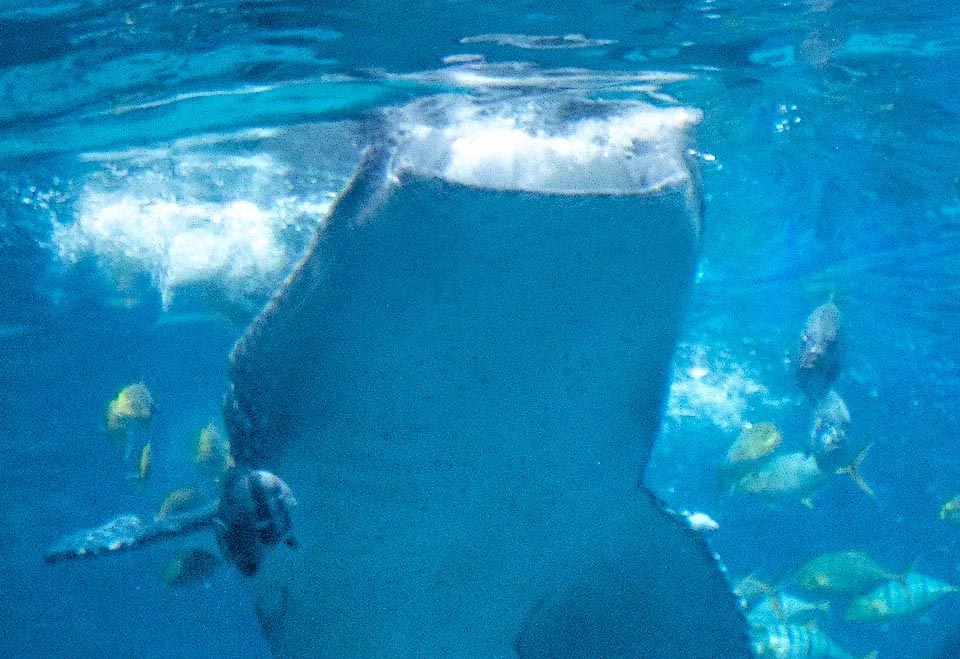
When the surface is rich in plankton it positions itself vertically and by filling its mouth with water, which comes out filtered by gills, it separates the prey © Giuseppe Mazza
The head, broad and flat, with very small eyes if compared with the size, ends in an enormous mouth, wide even a metre and a half, placed in front and not under, as usually occurs in the world of the sharks.
Despite the 300 rows of tiny teeth, now useless traces of a far past, the feeding of this giant is entrusted to a particular filtering structure formed by solid notches placed on the gill blades. In fact, it nourishes mainly of plankton, especially krill, small bluefishes not more than 10 cm long, such as groups of sardines, anchovies and young mackerels, but also jellyfishes, shrimps and squids.
When the waters where it is swimming are poor of food, it seizes it advances calmly the mouth open, but if it realizes that in surface there is a hearty meal in sight, it places in a vertical position, almost surfacing, and opens the mouth sucking up huge quantities of water.
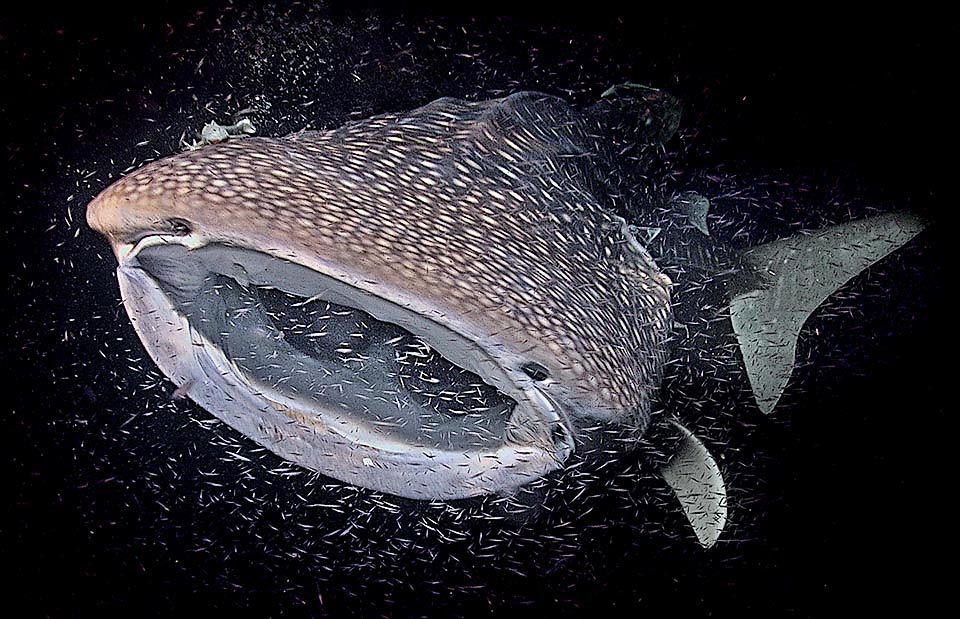
It feeds on plankton, especially krill, but also small blue fish less than 10 cm long, such as sardines, anchovies and young mackerel, jellyfish, shrimp and squid © Luis Pérez Berrocal.
Closing the mouth this is compressed in the oral cavity because the gills open only for a few moments after slowing its exit. Between the tiny teeth of the pharynx, can pass only particles less than 2 mm long, whilst the others, due to the pressure, go towards the pharynx, almost parallel to the filter, without clogging it. Operations that, repeated, opening and closing the mouth 7-28 times per minute, can pay even a ton of food per day.
There are two other big pelagic sharks with similar feeding: the Basking shark (Cetorhinus maximus), that with its 8 m of length is the second in the ranking by size, and the Megamouth shark (Megachasma pelagios) that is satisfied with its 5 m.
The famous Blue whale (Balaenoptera musculus) reaches the 33 m, but its is “out of competition” because it is not a fish but a mammal.
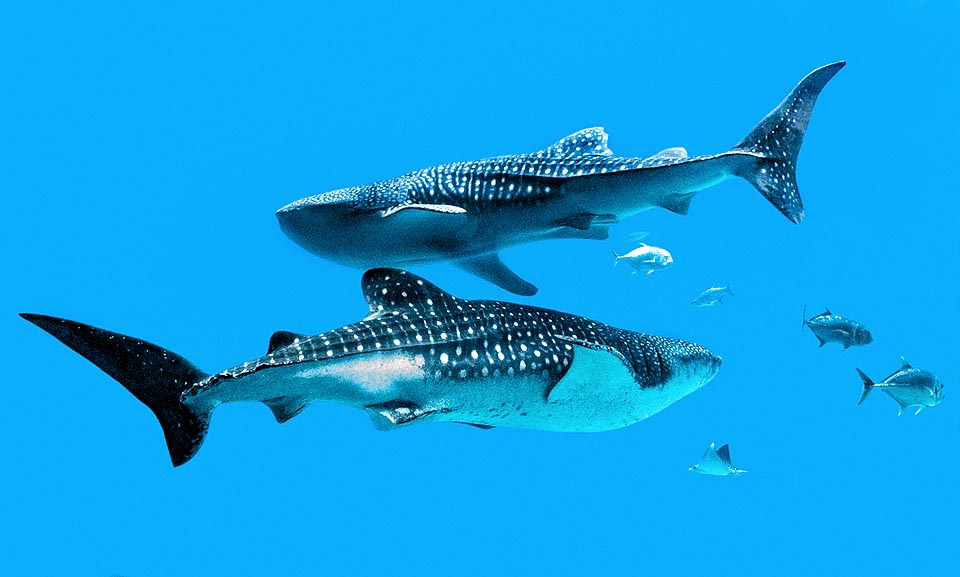
Rhincodon typus is an ovoviviparous species. Embryos develop inside fertilized eggs protected by mother’s body. At birth, young measure about 50 cm © Giuseppe Mazza
Ethology-Reproductive Biology
Rhincodon typus is an ovoviviparous species. That means that the embryos develop inside fecundated eggs protected by the maternal body and the newborns are expelled only after the hatch. It seems that they measure a little more than half a metre.
In one female have been found about 300 eggs long 42-52 cm and 14 cm broad with embryos at different stages of development. Some newborns, just out from the shell, were already apt for the life at sea.
Like all sharks, the males of the Whale shark have two copulatory organs, called pterygopodia, formed by the back side of the elongated pelvic fins that serve as tubes for conveying the sperm in the cloaca of the female.
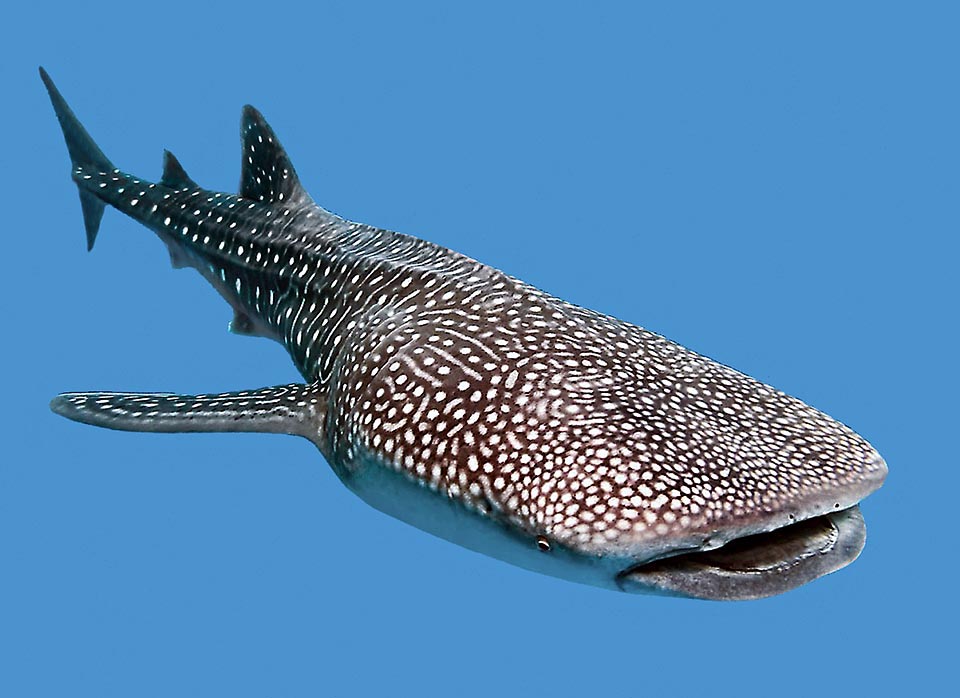
A juvenile. The Whale Shark has fed Asian fish markets for years with its tasty meat, liver oil, fin soups and is now among the endangered species © Gianemilio Rusconi
It is thought that after the mating this one keeps it for fecundating the eggs a little at a time thus having a flux of births prolonged and constant.
The coupling of the Rhincodon typus has been observed twice in St. Helena. They are long-lived fishes that reach the sexual maturity when 30 and it seems that they can exceed the century.
Even if no precise data are available, the resilience of the species is unluckily very weak, because it has been calculated that more than 14 years are needed for doubling the membres.
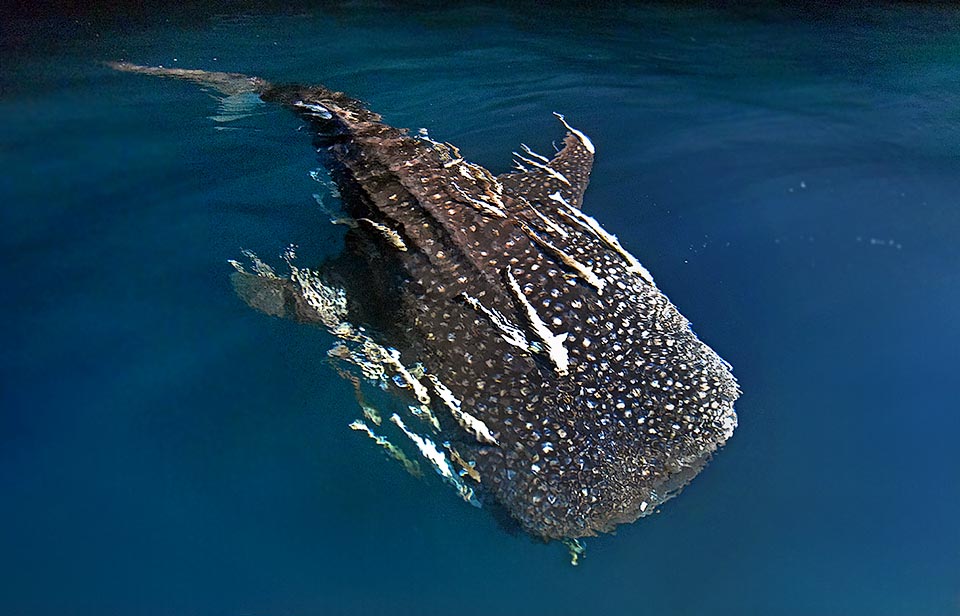
3 m pup with remoras attached. Rhincodon typus is harmless to humans and in some tourist locations, at night, it attracts plankton with light to make them run © Gianemilio Rusconi
Animal often swimming slowly in surface, easy to sight and to harpoon, the Whale shark has nurtured for years the Asian fish markets due to its tasty flesh, the oil extracted from the liver, fin soups and various beliefs, and the index of vulnerability to fishing, very high, marks 87 on a scale of 100.
Rhincodon typus therefore appears since 2016 as “EN, Endangered” in the IUCN Red List and is protected at an international level, but the massacres of the past, combined with illegal fishing, are still felt.
Synonyms
Rhiniodon typus (Smith, 1828); Rhinodon typicus Müller & Henle, 1839; Rhinodon typicus Smith, 1845; Micristodus punctatus Gill, 1865; Rhinodon pentalineatus Kishinouye, 1901.
→ For general information about FISH please click here.
→ For general information about CARTILAGINOUS FISH please click here.
→ For general information about BONY FISH please click here
→ To appreciate the BIODIVERSITY of CARTILAGINOUS FISH please click here.
→ To appreciate the BIODIVERSITY of BONY FISH please click here.
